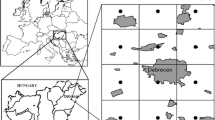Summary
Using climatic data from Fairbanks and rurally situated Eielson Air Force Base in Interior Alaska, the growth of the Fairbanks heat island was studied for the time period 1949 – 1997. The climate records were examined to distinguish between a general warming trend and the changes due to an increasing heat island effect. Over the 49-year period, the population of Fairbanks grew by more than 500%, while the population of Eielson remained relatively constant. The mean annual heat island observed at the Fairbanks International Airport grew by 0.4 °C, with the winter months experiencing a more significant increase of 1.0 °C. Primary focus was directed toward long-term heat island characterization based on season, wind speed, cloud cover, and time of day. In all cases, the minima temperatures were affected more than maxima and periods of calm or low wind speeds, clear winter sky conditions, and nighttime exhibited the largest heat island effects.
Similar content being viewed by others
Author information
Authors and Affiliations
Additional information
Received August 17, 1998 Revised March 26, 1999
Rights and permissions
About this article
Cite this article
Magee, N., Curtis, J. & Wendler, G. The Urban Heat Island Effect at Fairbanks, Alaska. Theor Appl Climatol 64, 39–47 (1999). https://doi.org/10.1007/s007040050109
Issue Date:
DOI: https://doi.org/10.1007/s007040050109




